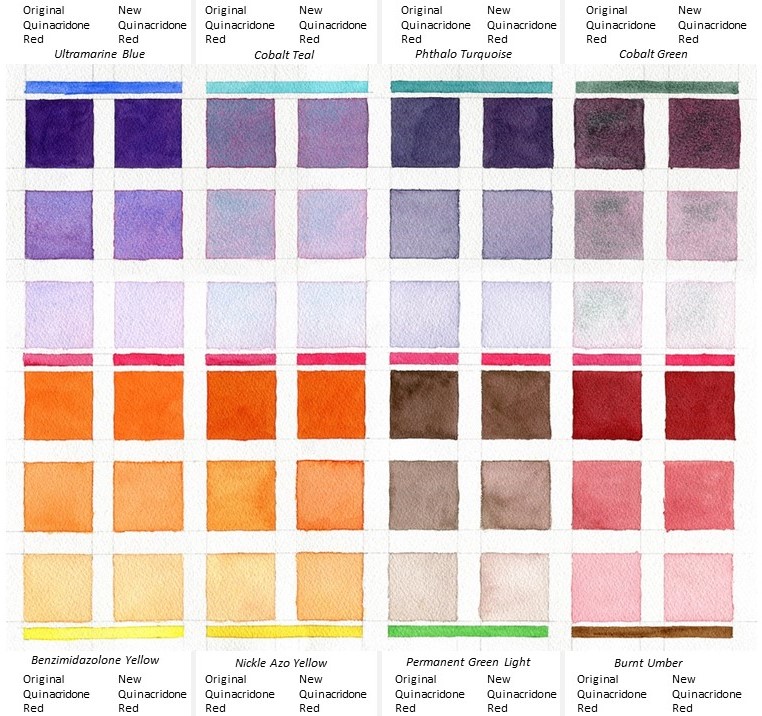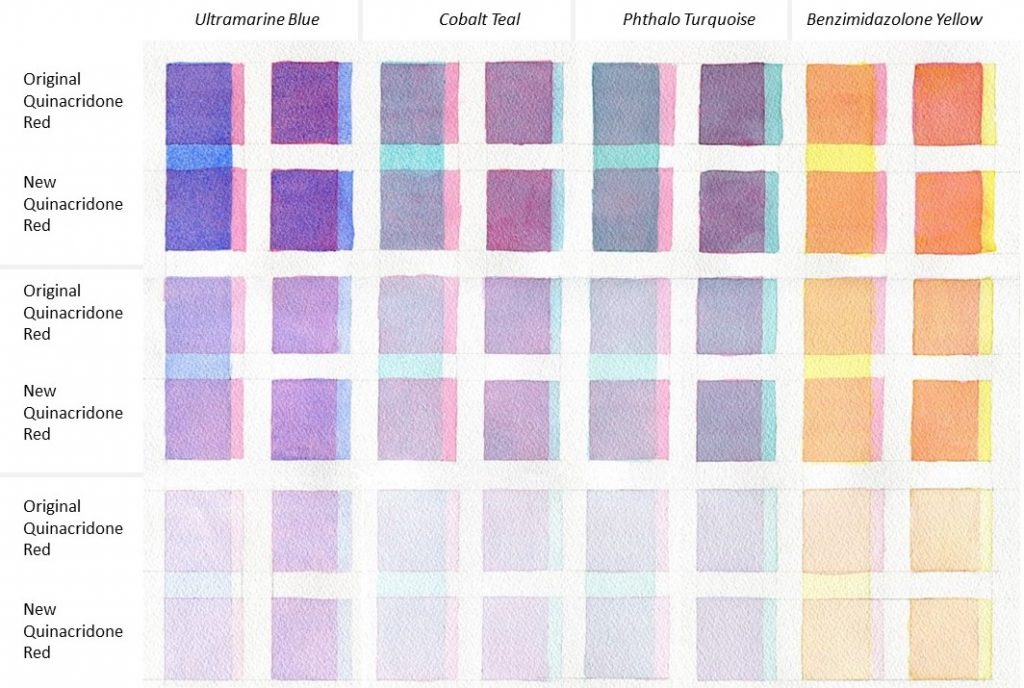We found a version of QoR Quinacridone Red’s PV19 pigment that creates a watercolor with a stronger tint strength and will begin using it in place of the older option. QoR Quinacridone Red remains Lightfast I, transparent, non-granulating, and staining.
The two paints handle and behave well.
Both versions of QoR Quinacridone Red are alike in handling, dissolve easily into water, move wet-in-wet, and rewet beautifully. Since the new pigment creates a watercolor with stronger tint strength, less paint will be needed to achieve previous results. Image 1 shows the original and new versions of this paint in paired washes diluted to obtain approximately the same color strength. Due to the difference in pigment strength, it took more water to dilute the new pigment and judgements were made by eye.
There is a slight color difference in masstone.
As seen in Image 1 above, our new Quinacridone Red pigment is slightly less purple-leaning than the original, which had a color bias towards Quinacridone Magenta. The small color difference is seen most clearly when less water dilutes the paint. Should the color change be too much for your artwork, adding a little QoR Permanent Alizarin Crimson (PR177) to the new Quinacridone Red (PV19) will bring the color closer to the original in masstone. To amend the tint, mix in a little Quinacridone Magenta (PR122) instead of Permanent Alizarin Crimson.
In mixes and glazes, the color change is almost imperceptible.
Mixes:
Both versions of Quinacridone Red create blends and glazes that are close to indistinguishable in color. In Image 2, we mixed each of the Quinacridone Reds with a range of colors and applied them in 2 groups of vertical triads of dark, middle and light washes. There is a bar of the unmixed color at the top and bottom of each vertical trio of mixes. We included multiple greens and yellows in hopes these might highlight differences. Mixes occurred on a palette and were judged by eye. Given the superior tinting strength of the new pigment, weighed mixes would have created a redder result with that paint, which would have impacted comparisons.

With these mixes, paired columns of reds place the original Quinacridone Red to the left and the new to the right. At the top, we mixed the reds with QoR Ultramarine Blue, Cobalt Teal, Phthalo Turquoise, and Cobalt Green. On the bottom rows of mixes we have QoR Benzimidazolone Yellow, Nickel Azo Yellow, Permanent Green Light, and Burnt Umber Natural. There is a slight change in the darker more intense mixes, with one or the other Quinacridone Red version resulting in a brighter result depending on whether it leaned more violet (old version) or orange (new version). However, generally the results showed very little difference between mixes made with the two reds.
Glazes:
Next we placed the two Quinacridone Reds as the first or second layer in pairs of glazes, visible in Image 3. Each pair is shown in columns of three dilutions, from less water at the top of the test to more water and a lighter glaze at the bottom. Here the reds are organized horizontally in three groups of pairs, with the original red in the top and the new red in the bottom of each pair. The colors with which they are glazed include, from left to right: QoR Ultramarine Blue, Cobalt Teal, Phthalo Turquoise, and Benzimidazolone Yellow. In the first column, the non-red paint formed the first layer, with the red glazed over it. In the second column, the red formed the first layer with the other color glazed on top.
As with mixing, we saw very little difference in the optical mixes created by glazing.

We hope you will be as pleased with the new version of QoR Quinacridone Red as we are. The change will start with batch W0395988, which should be in Retail stores the spring of 2021.
Happy painting!

